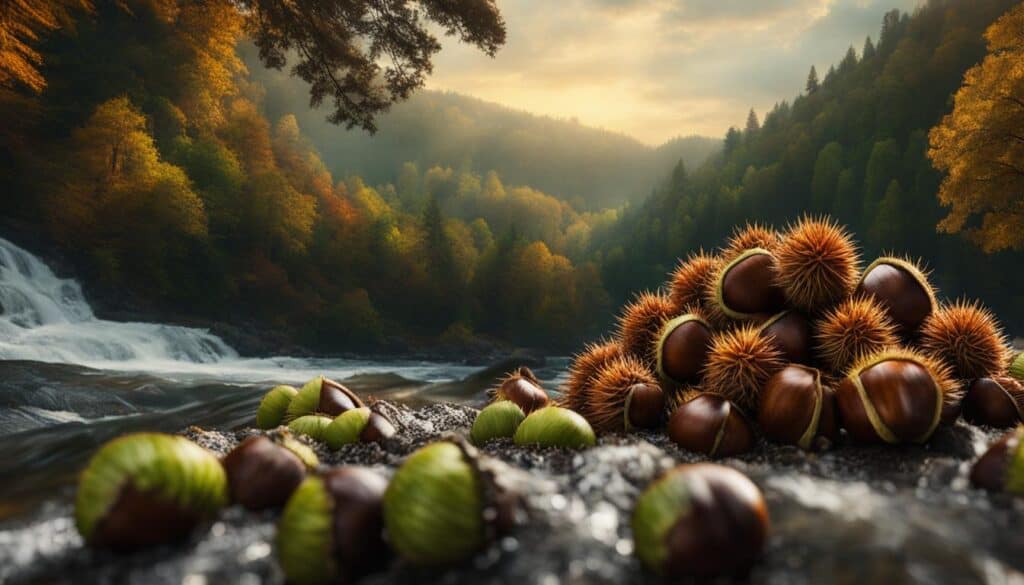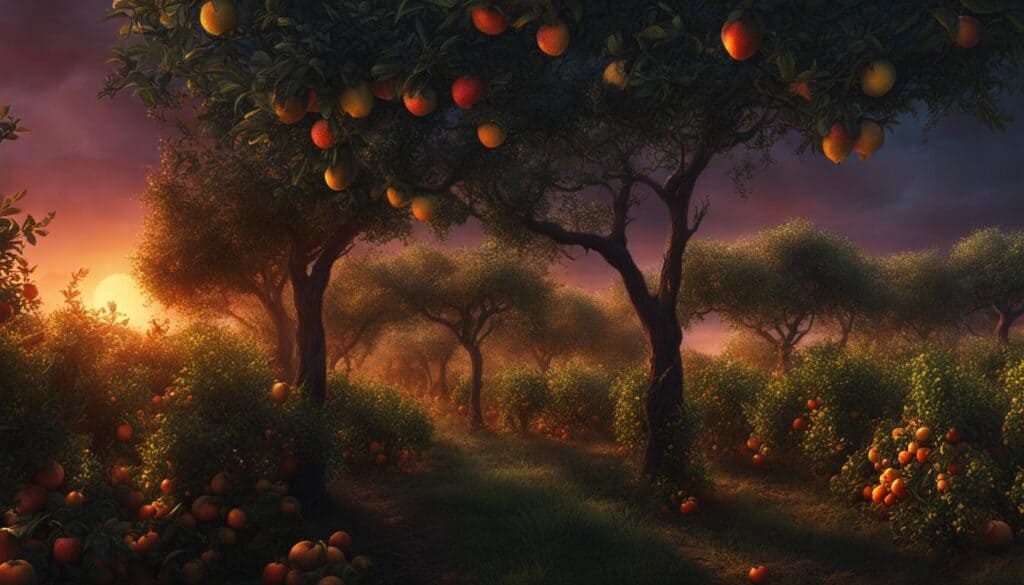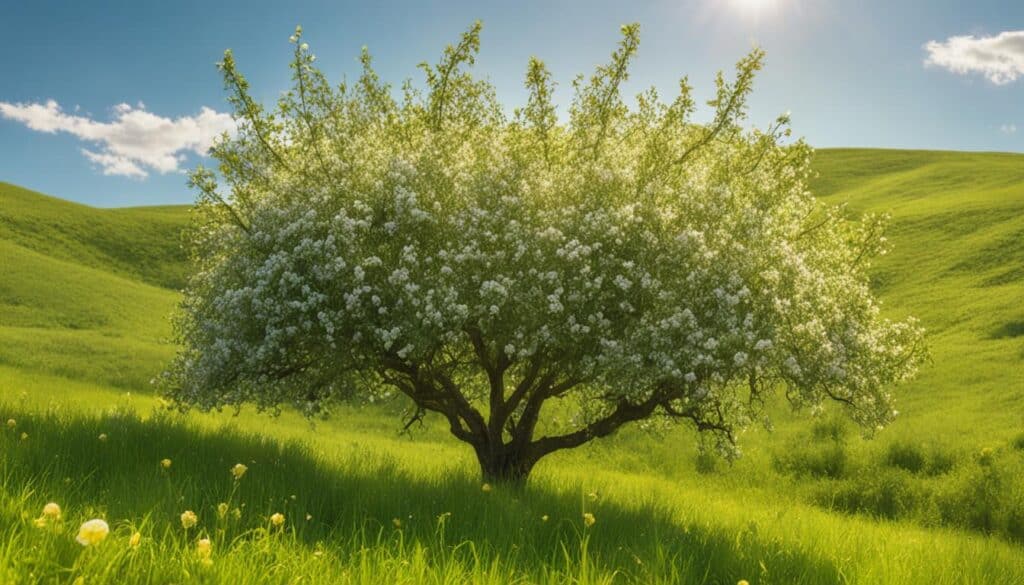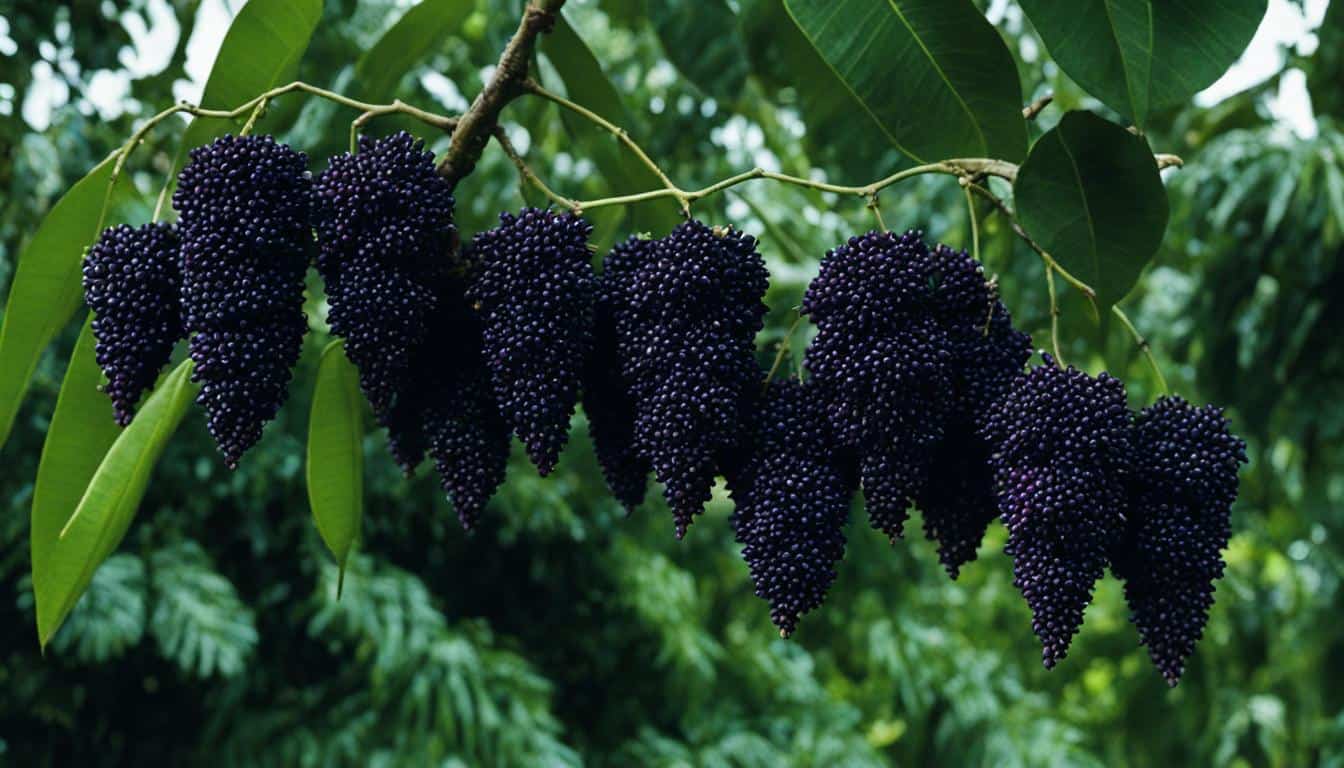Have you ever come across a big fruit with spikes? These spiky fruits, also known as large fruits with thorns, are a mesmerizing sight to behold. Their unique appearance, covered in short spikes and boasting a bright orange color, immediately catches the eye. But what lies beneath the intimidating exterior?
While these fruits may not be a flavor explosion for the taste buds, their cultural significance and health benefits make them truly worth exploring. Let’s dive deeper into this fascinating culinary treasure and uncover the wonders hidden within.
Key Takeaways:
- The big fruit with spikes is an exotic culinary treasure.
- Its taste may be bland, but its cultural significance and health benefits make it popular.
- In Vietnam, the fruit is used in traditional dishes like xôi gấc.
- Gac fruit is rich in beta-carotene and used in natural supplements.
- The vibrant color of the fruit adds visual interest to dishes and beverages.
The Gac Fruit: Cultural Significance and Health Benefits
The gac fruit holds significant cultural value in Vietnam, where it is revered for its vibrant red color and versatile culinary applications. One of the most popular dishes made from gac fruit is xôi gấc, a traditional red sticky rice dish enjoyed during special occasions, particularly Tet, the Vietnamese New Year. The stunning red hue of the fruit symbolizes good luck, making it an auspicious addition to celebratory meals.
Beyond its cultural significance, the gac fruit is renowned for its exceptional health benefits. It is a rich source of beta-carotene, containing even higher levels than carrots. Beta-carotene is a precursor to vitamin A and is known for its antioxidant properties and role in supporting healthy skin and vision.
In addition to beta-carotene, the seeds of the gac fruit are used in traditional Chinese medicine to treat various ailments, including swelling and sores. The fruit’s seeds are believed to possess anti-inflammatory properties and are valued for their potential therapeutic effects.
| Key Points | Benefits |
|---|---|
| Cultural Significance | The gac fruit is an integral part of Vietnamese traditions and is prominently featured in festive dishes, symbolizing good luck. |
| High Beta-Carotene Content | Gac fruit is a potent source of beta-carotene, a key nutrient associated with various health benefits, including antioxidant properties and support for skin and vision health. |
| Traditional Medicinal Use | The seeds of the gac fruit are utilized in traditional Chinese medicine to treat swelling and sores, thanks to their anti-inflammatory properties. |
With its cultural significance and remarkable health benefits, the gac fruit continues to captivate both culinary enthusiasts and health-conscious individuals alike. Whether enjoyed in traditional Vietnamese dishes or incorporated into natural supplements, the gac fruit stands as a testament to the power of nature’s wonders.
A Closer Look at Jaboticabas: Nature’s “Tree Grapes”
Jaboticabas are small violet fruits that resemble grapes. They grow on trees and often wind their way around the trunk, giving them the nickname “tree grapes.” Unlike grapes, the jaboticaba tree is cauliflorous, meaning its flowers and fruits grow directly from the trunk.
The skin of the jaboticaba fruit is edible but has a harsh, herbal flavor due to its high tannin content. To consume the fruit, a small hole is made in the skin, and the white flesh inside is sucked out. There are various varieties of jaboticabas, each with its own unique flavor profile.
They are immensely popular in Brazil, where they are eaten fresh and used to make jams and wine.
- Jaboticabas are native to Brazil and can be found in the Amazon rainforest as well as other tropical regions.
- The fruit is rich in antioxidants, vitamins, and minerals, making it a nutritious addition to any diet.
- Due to their delicate nature, jaboticabas have a short shelf life and are best enjoyed soon after harvest.
“Jaboticabas are a true taste of the tropics, with their vibrant color and unique flavor. They offer a delightful burst of sweetness with a hint of tartness, making them a perfect snack or ingredient in various dishes,” says Maria Silva, a Brazilian chef known for her innovative use of tropical fruits.
Here is a comparison of the nutritional value per 100g of jaboticabas and grapes:
| Nutrient | Jaboticabas | Grapes |
|---|---|---|
| Calories | 45 | 69 |
| Carbohydrates | 11g | 18g |
| Fiber | 0.6g | 0.9g |
| Vitamin C | 15mg | 3.2mg |
| Calcium | 11mg | 10mg |
| Potassium | 276mg | 191mg |
“Jaboticabas are not only delicious but are also packed with nutrients. They are an excellent source of vitamin C and potassium, which are essential for a healthy immune system and proper heart function,” explains Dr. Ana Lopez, a nutritionist specializing in tropical fruits.
Next time you come across jaboticabas or “tree grapes” in your local market or during your travels, be sure to give them a try. Their unique flavor, vibrant color, and nutritional benefits make them a standout fruit in the world of tropical delicacies.
The Decline of Corsican Chestnut Forests
Corsican chestnut forests, known for their abundant chestnuts, are facing a troubling decline. A combination of factors has contributed to the challenges faced by these iconic forests.
One significant factor is rural flight, where many young people are leaving the Castagniccia region in search of job opportunities in coastal areas or mainland France. As a result, the forests are being abandoned and left untended, leading to a decrease in chestnut yields.
Furthermore, the importation of cheaper chestnuts from mainland France has had a negative impact on the Corsican chestnut industry. These imported varieties are not bred for flour, which is a staple ingredient in Corsican cuisine, further impacting the local chestnut market.
Another contributing factor is the rise of rural gentrification, with non-resident owners buying property in the area. Unfortunately, many of these owners lack the skills and knowledge necessary to properly steward the land and maintain the health of the chestnut forests.
This combination of rural flight, importation of cheaper chestnuts, and rural gentrification has led to the decline of Corsican chestnut forests.
The Significance of Corsican Chestnuts in History
Corsican chestnuts have played a significant role in the history and culture of Corsica. During Genoese occupation, the Corsicans learned the technique of grafting wild chestnuts onto improved cultivars specifically bred for making flour. This skill enabled the Corsicans to make bread and sustain themselves on the challenging terrain.
This ability to produce chestnut flour not only provided sustenance but also fostered a sense of resiliency and independence among the Corsican people. In a land where agricultural options were limited, the chestnut industry became a lifeline, allowing the Corsicans to thrive even in the harshest conditions.
I feel a deep connection to these chestnut trees. They have been part of our lives for generations, providing us with food, warmth, and a sense of identity. They are a symbol of our resiliency and strength as a people.
For centuries, Corsican chestnuts served as the main source of food for the island’s inhabitants. From chestnut bread to chestnut porridge and everything in between, the versatility of chestnut flour allowed for a diverse range of culinary creations.
The Economic and Cultural Impact
The importance of chestnuts in Corsican history extended beyond sustenance. The chestnut industry brought economic stability to the region, providing jobs and income for the local population. Chestnut farming became a way of life for many families, passing down their knowledge and expertise from generation to generation.
As the chestnut industry flourished, it also became intertwined with the island’s cultural identity. Chestnut festivals and celebrations became a cherished part of Corsican traditions, showcasing the deep-rooted connection between the people and the land. The resilience of the Corsican chestnuts mirrored the resilience of the Corsican people themselves.
The chestnut trees have witnessed our history, our triumphs, and our struggles. They have stood tall through wars and hardships, reminding us of our ability to adapt and overcome. They are a testament to our resiliency as a community.
However, the decline of chestnut forests after World War I marked a turning point for the Corsican chestnut industry. The loss of able-bodied labor due to war casualties, coupled with the subsequent recession, led to the abandonment of many chestnut orchards. The industry that had once served as the backbone of Corsican livelihoods began to fade away.
Despite the challenges faced by Corsican chestnuts, efforts are being made today to revitalize the industry. By preserving the ancient knowledge of cultivating chestnut trees and introducing improved cultivars, there is hope for a revival of the once-thriving chestnut forests.
The Legacy of Corsican Chestnuts
The legacy of Corsican chestnuts extends far beyond their economic and cultural significance. These resilient trees are a living testament to the history and heritage of the Corsican people. They serve as a reminder of the tireless efforts made by generations before us to ensure our survival and prosperity.
As we look to the future, it is crucial to recognize the importance of preserving and protecting the remaining chestnut forests. They hold not only ecological value but also a deep connection to our roots and the resilience that defines us as Corsicans.
By supporting initiatives that promote the cultivation and consumption of Corsican chestnuts, we can honor our history, secure our cultural heritage, and create a sustainable future for generations to come.

The Impact of Rural Gentrification on Chestnut Forests
Rural gentrification is posing a significant challenge to the preservation of chestnut forests in Corsica. The increasing popularity of the island as a vacation destination has led to a rise in real estate prices, making it difficult for local Corsicans to afford property. As a result, many chestnut forests are now owned by absentee or seasonal owners who lack the necessary skills and awareness for land stewardship.
These absentee owners, often referred to as “functionaries,” prioritize short-term gain over the long-term health and maintenance of the forests. They may not invest in essential practices such as reforestation, sustainable harvesting, and ecosystem conservation. The lack of connection and understanding of the local environment further exacerbates the neglect and decline of these ancient ecosystems.
The loss of capable individuals who have a deep connection to the land is a critical factor contributing to the deterioration of chestnut forests. Without knowledgeable and dedicated stewards, the forests face challenges such as invasive species, disease outbreaks, and unsustainable harvesting practices.
Comparison of Local and Absentee Ownership
| Aspect | Local Ownership | Absentee Ownership |
|---|---|---|
| Land Stewardship | Deep understanding of the local environment and ecosystem conservation | Lack of awareness and investment in long-term forest health |
| Connection to the Land | Strong cultural ties and intergenerational knowledge | Remote ownership without personal connection to the community |
| Economic Impact | Support for local communities and sustainable practices | Focus on short-term gain and potential negative effects on the local economy |
Efforts to address rural gentrification and promote responsible land stewardship are crucial for the preservation and revitalization of chestnut forests. Strategies such as incentivizing local ownership, implementing land use policies that prioritize sustainable practices, and providing training and support for forest management can help ensure the long-term health and conservation of these valuable ecosystems.

The Potential Threat to Tree Crops in the US
The decline of chestnut forests in Corsica raises concerns about the future of tree crops, particularly in the US. As a lover of nature and advocate for sustainable agriculture, I believe it’s crucial to recognize the value of renovating and preserving old trees. Unfortunately, in many cases, the focus is on planting new trees rather than investing in the care and maintenance of existing ones. This mindset stems from misconceptions about the economic viability of renovating old orchards and the perception that old trees are disease vectors.
However, the example of Corsica serves as a powerful reminder of the importance of preserving ancient tree ecosystems and the need for long-term investment in both land and tree crops. By renovating and revitalizing old trees, we can not only preserve biodiversity but also tap into the unique benefits they offer.
The Value of Renovating Old Trees
Renovating old trees, whether they are chestnuts, apples, or any other tree crops, holds undeniable value. Here are a few reasons why:
- Established root systems: Old trees have extensive and well-developed root systems that provide stability and access to deep water and nutrients. This helps them withstand drought and other environmental stresses.
- Increased resilience: Older trees have already weathered various environmental conditions and are more resilient to pests, diseases, and extreme weather events.
- Unique flavors and characteristics: Old trees often produce fruit with exceptional flavors and unique characteristics that are distinct from those grown on young trees. This can be a selling point for high-quality, artisanal products.
- Cultural heritage: Ancient trees hold cultural significance and tell the stories of generations past. Preserving these trees connects us to our history and is vital for the cultural identity of communities.
It’s time to challenge the notion that old trees are a hindrance to progress. Instead, let’s recognize their value and invest in their renovation and preservation. By doing so, we can not only protect and restore ancient tree ecosystems but also promote sustainable agriculture and ensure the future of tree crops.
| Threats to Tree Crops | Potential Solutions |
|---|---|
| Lack of recognition for the value of old trees | Education and awareness campaigns highlighting the benefits of renovating and preserving old trees. |
| Misconceptions about economic viability | Showcasing success stories of renovated orchards and economic benefits such as premium pricing for unique flavors. |
| Perception of old trees as disease vectors | Providing accurate information about disease management and demonstrating that proper care and maintenance can mitigate risks. |
| Limited access to skilled labor | Investing in training programs and fostering collaborations between experienced tree farmers and younger generations. |
It’s time to shift our perspective and embrace the value of renovating old trees. By doing so, we can ensure a sustainable future for tree crops, preserve biodiversity, and protect the cultural heritage associated with ancient tree ecosystems.

The Importance of Chestnut Forest Restoration
Restoring and revitalizing chestnut forests is crucial to preserving the rich cultural heritage and biodiversity associated with these ecosystems. The neglect and abandonment of chestnut forests in Corsica highlight the need for concerted efforts in chestnut forest restoration.
This restoration involves not only physical labor but also policy changes and support from local communities and government entities. Long-term access to land, lifetime leases, and the infusion of skilled labor are essential for the sustainable management and upkeep of chestnut forests.
By taking action to preserve ancient ecosystems, we can ensure that the legacy and benefits of tree crops continue to thrive.

The Challenges of Growing Apples in the South
Growing domesticated fruit, particularly apples, in the southern regions of the United States presents unique challenges. The hot and humid climate creates favorable conditions for pests and diseases, making it essential to select apple cultivars with a tolerance to these challenges. While Northern and Western apple growers refer to the South as “the final frontier,” there are cultivars available that thrive in the southern climate. The ability to identify and cultivate disease-resistant varieties is key to successful apple production in the South.
When it comes to growing apples in the South, one of the primary challenges is the region’s climate. The hot and humid weather provides an ideal breeding ground for pests and diseases that can significantly impact apple orchards. To combat these issues, apple growers in the South need to select cultivars that are specifically bred to tolerate and resist common pests and diseases found in the region.
Fortunately, there are apple varieties available that have been developed with a tolerance to pests and diseases commonly found in the Southern climate. These cultivars have undergone rigorous breeding programs to ensure their resilience and ability to withstand the challenges of the region. By planting disease-resistant apple varieties, growers can reduce the reliance on chemical pesticides and promote a more sustainable approach to apple production.
One example of a disease-resistant apple variety is the Arkansas Black apple. This cultivar is known for its high resistance to apple scab, a fungal disease that thrives in moist conditions. The Arkansas Black apple is also well-adapted to the Southern climate, making it an excellent choice for growers in the region.
In addition to selecting disease-resistant apple cultivars, Southern apple growers can also implement integrated pest management strategies to further protect their orchards. This approach involves a combination of cultural, biological, and chemical control methods to manage pests and diseases in a more sustainable and environmentally-friendly manner.
| Challenges of Growing Apples in the South | Tolerance to Pests and Diseases | Southern Climate |
|---|---|---|
| Hot and humid weather | Select disease-resistant apple cultivars | Plant cultivars adapted to the Southern climate |
| Pests and diseases | Implement integrated pest management strategies | Reduce reliance on chemical pesticides |
| Disease-resistant apple varieties | Arkansas Black apple | Well-adapted to the Southern climate |
Successfully growing apples in the Southern climate requires careful consideration of cultivar selection, pest and disease management, and climate adaptation. By implementing the right strategies and utilizing disease-resistant apple varieties, growers can overcome the challenges and achieve successful apple production in the South.

Conclusion
Throughout this exploration of big fruit with spikes, we have encountered a fascinating array of cultural, culinary, and environmental wonders. From the gac fruit in Vietnam with its symbolic significance and health benefits, to the jaboticabas in Brazil resembling “tree grapes,” each spiky fruit offers a unique experience that captivates the senses.
However, we must also acknowledge the challenges faced by ancient ecosystems such as the decline of chestnut forests in Corsica and the difficulties of growing apples in the Southern United States. These serve as reminders of the importance of land stewardship and the preservation of these remarkable environments.
By truly understanding and appreciating these big fruits with spikes and the rich ecosystems in which they thrive, we can forge a deeper connection to the wonders of nature. Let us embrace these diverse and intriguing fruits, valuing the delicate balance between cultural heritage, culinary exploration, and environmental preservation.
FAQ
What is the big fruit with spikes?
The big fruit with spikes is a fascinating and exotic culinary treasure. It comes in various sizes, with a bright orange color and short spikes covering its surface.
What is the taste of the big fruit with spikes?
Unfortunately, the taste of the big fruit with spikes is quite bland, with only a faint vegetable flavor.
What is the cultural significance of the gac fruit?
The gac fruit is particularly popular in Vietnam, where it holds significant cultural value. The flesh and seeds of the fruit are used to make xôi gấc, a red sticky rice dish commonly consumed during weddings and festivals, especially Tet, the Vietnamese New Year.
What are the health benefits of the gac fruit?
Gac fruit is rich in beta-carotene and is used in natural supplements. In traditional Chinese medicine, the seeds of the fruit are used to treat ailments such as swelling and sores.
What are jaboticabas?
Jaboticabas are small violet fruits that resemble grapes. They grow on trees and often wind their way around the trunk, giving them the nickname “tree grapes.”
How are jaboticabas consumed?
To consume the jaboticaba fruit, a small hole is made in the skin, and the white flesh inside is sucked out.
What is the significance of Corsican chestnuts in history?
Corsican chestnuts have played a significant role in the history and culture of Corsica. The ability to produce chestnut flour fostered a sense of resiliency and independence, which spilled over into their fight for autonomy from foreign rule.
What is rural gentrification?
Rural gentrification refers to the rise of non-resident owners buying property in rural areas and neglecting the long-term health and maintenance of the land.
What is the potential threat to tree crops in the US?
The lack of recognition for the value of renovating and preserving old trees is a prevalent issue. In many cases, planting new trees is favored over investing in the care and maintenance of existing ones.
Why is chestnut forest restoration important?
Restoring and revitalizing chestnut forests is crucial to preserving the rich cultural heritage and biodiversity associated with these ecosystems.
What are the challenges of growing apples in the South?
The hot and humid climate in the southern United States creates favorable conditions for pests and diseases, making it essential to select apple cultivars with a tolerance to these challenges.





Leave a Reply